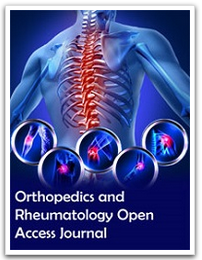Juniper Publishers - Wartenberg’s Syndrome: an Unusual Bilateral Case.
Orthopedics and Rheumatology Open Access Journal
Abstract
Wartenberg’s Syndrome is described as the entrapment of the superficial branch of the radial nerve, with only sensory manifestations and no motor deficits. Wartenberg’s syndrome may be associated with the symptoms of de Quervain’s tenosynovitis. A positive Tinel’s sign over the course of the nerve is the most common physical examination finding. For the surgical management there is evidence in the literature documenting the good result reported by simple neurolysis of the nerve and removing anatomical variations of the muscle brachioradialis. In this article we report an unusual bilateral case of this rare peripheral nerve compression.
Introduction
In 1932 Wartenberg as first author describe a compression of the radial sensory nerve in the third distally of the forearm, reporting five monolateral cases. He was so impressed by the similarity to the isolated involvement of the lateral cutaneous nerve of the thigh (Meralgia Paraesthetica), that he suggested the name Cheiralgia Paraesthetica [1,2].
In 1993 Lanzetta and Foucher describe 52 monolateral cases and reported 74% success rate in 23 patients who underwent surgical decompression who had failed conservative therapy [3].
From the anatomically point of view the superficial branch of the radial nerve start after the radial nerve bifurcates into the superficial radial nerve and posterior interosseous nerve, exits from under the brachioradialis at the junction of the proximal two-thirds to distal one-third of the forearm, courses distally into the forearm deep to the brachioradialis and approximately 8-9 cm proximal to the radial styloid becomes a subcutaneous structure by traveling between the brachioradialis and Extensor Carpi Radialis Longus tendons. The nerve continues to travel in the subcutaneous tissues and branches out into dorsal digital nerves responsible for afferent sensory input from the dorsum of the thumb, index, and middle fingers proximal to the proximal interphalangeal joints [4,5].
From the aetiopathogenetic point of view the superficial branch of the radial nerve, due to its anatomic location, is vulnerable to compression from trauma, masses, and constriction from the fascia connecting the brachioradialis and extensor carpi radialis longus. Specifically, in pronation, the brachioradialis and the extensor carpi radialis longus compress the nerve. Wartenberg’s syndrome is a dynamic compressive neuropathy. Trauma is a common etiology for compression,which can occur from direct pressure on the nerve (i.e. by a tight wristwatches or handcuffs) or from a stretch injury to the nerve (i.e. during a closed reduction of a forearm fracture), other etiologies have been implicated, including lipoma and bony spurs, or work-related activities demanding repetitive supination and pronation.
Case Report
A 47 year-old man, right-hand-dominant man presented with tingling, paresthesias, and pain over the dorsal aspect of his left thumb of 6 months’ duration. On physical examination, the patient had a positive Tinel’s sign over distribution of his left superficial branch of the radial nerve. A preoperative EMG was positive for radial nerve compression and a sonography not show abnormal mass or intraneural lesions.
In the operating room, an oblique incision at a right angle to the superficial branch of the radial nerve was made over the dorsoradial aspect of the forearm at the level of the musculotendinous junction of the brachioradialis. The nerve was identified in the subcutaneous tissue. The tendinous portions of the brachioradialis and extensor carpi radialis longus were identified. Continuing the dissection proximally, the musculotendinous junction of the brachioradialis was identified. At this level, the superficial branch of the radial nerve was noted to exit at the dorsal aspect of the brachioradialis tendon. Upon dissecting the nerve proximally, a fascial ring from the dorsal edge of the brachioradialis was encountered circumferentially constricting the nerve.
The fascial ring was sharply incised while protecting the nerve. Upon releasing the fascial ring, an area of compression was clearly visible on the surface of the nerve.
Discussion
Wartenberg’s Syndrome is described as the entrapment of the superficial branch of the radial nerve, with only sensory manifestations and no motor deficits. Patients typically report pain and dysesthesias on the dorsal radial forearm radiating to the thumb and index finger.
No weakness or muscular abnomalies are present, in case of presence of this symptoms a more proximal lesion (of the cervical spine, posterior cord of the brachial plexus, or radial nerve proper) or perhaps a mass in the radial tunnel large enough to affect both the PIN and SRN can posed in differential diagnosis [6]. Wartenberg’s syndrome may be associated with the symptoms of de Quervain’s tenosynovitis.
A positive Tinel’s sign over the course of the nerve is the most common physical examination finding. Spontaneous resolution of the symptoms is common, for conservative treatment removal of the external compression like inciting element such as a wristwatch is essential.
For non-surgical treatments good result are reported by splinting, tens and non steroidal anti-inflammatory drugs. For the surgical management there is evidence in the literature documenting the good result reported by simple neurolysis of the nerve and removing anatomical variations of the muscle brachioradialis? [7,8].
To Know More
About Orthopedics and
Rheumatology Open Access Journal Please click on:
For more Open Access
Journals in Juniper Publishers please click on:
For more about Juniper Publishers Please click on:



Comments
Post a Comment